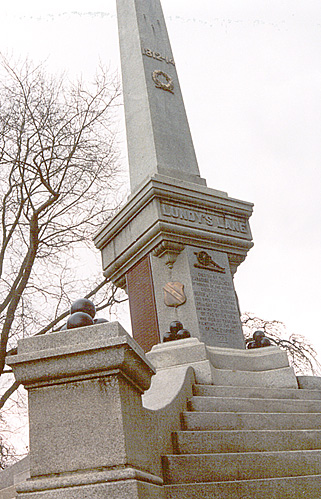 As General Brown had left the field with a wound, he ordered General Ripley to lead the American army back to camp. The next morning, Captain Symmes commanded the first platoon of the column sent back to the battlefield “to bury the dead.” The march was short lived, as a military conference decided to withdraw to the camp at Chippawa, and eventually, to Fort Erie. The battle of “Bridge Water,” now known as the Battle of Lundy’s Lane, was over.
As General Brown had left the field with a wound, he ordered General Ripley to lead the American army back to camp. The next morning, Captain Symmes commanded the first platoon of the column sent back to the battlefield “to bury the dead.” The march was short lived, as a military conference decided to withdraw to the camp at Chippawa, and eventually, to Fort Erie. The battle of “Bridge Water,” now known as the Battle of Lundy’s Lane, was over.
Monument to Battle of Lundy's Lane
The regiment lost 11 killed in action, 30 wounded and 2 missing. In Symmes company alone, 8 enlisted men were killed in action, and 2 men mortally wounded. 1 officer had been wounded, and at least 5 enlisted men, with 1 man missing. Among the killed in action was Corporal Charles Mason, a Canadian native. The oldest man in the company, 45 year old Asa Pease, was also among the slain.
As Captain Symmes said after the war, the men “had nothing to flatter or please them, but the pleasure of recounting to one another, their engagements and arderous [sic] tours of duty. This would have been sufficient compensation thro life, had not other regiments…been loaded with Official honors for doing their duty well. If any Regt. found it possible to do more than their duty, the 1st have done no less.”
General Brown’s report of the battle contained numerous errors and misstatements. The report stated that the 1st Infantry had retreated and “gave way” before its officers could stop and reform the men, which was utterly false. The regiment had “about faced”, and marched 50 yards back down the slope of the heights, on an order from Lt. Col. Nicholas. The colonel eventually faced a court martial and would be cleared for his decision to order the men to “about face.” Captain Symmes would make it his life-long pursuit to set the record straight. He always thought that the truth would finally prevail and “justice yet be done.” Unfortunately, until recently, the record of the 1st Regiment at Lundy’s Lane remained tarnished by Brown’s Official report of the battle.
Symmes wrote “I have long wished…to thank…[General Armstrong] for sending the 1st Regt. to Canada because it afforded an opportunity of gathering Laurels, its true the laurels it gathered are hidden but should they not be searched out, [and] they will sooner or later, like hidden truth, spontaneously arise…to be heard from; the whole Regt. owes General Armstrong our thanks.”
The First Infantry Regiment, had traveled from the far frontier to arrived mid-course in a desperate and bloody night battle. Under strength, untried and unknown to General Brown, they fought hard and did their duty. Their story, lost among the inflated egos and reputations of Generals Brown, Scott and Porter, is an American story of faithful service to their country, without pretensions.
"On the Canada Line” The Story of the 1st United States Infantry at the Battle of Lundy’s Lane, July 25th 1814
Back to Table of Contents -- War of 1812 #4
Back to War of 1812 List of Issues
Back to MagWeb Magazine List
© Copyright 2005 by Rich Barbuto.
This article appears in MagWeb (Magazine Web) on the Internet World Wide Web.
Other articles from military history and related magazines are available at http://www.magweb.com